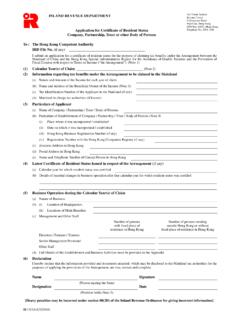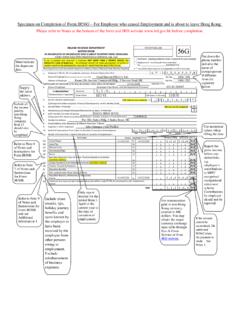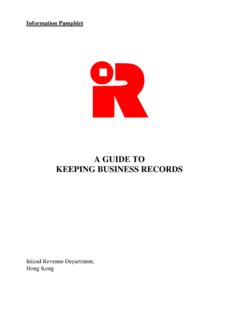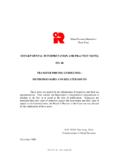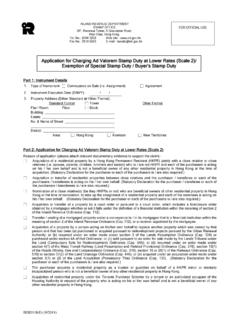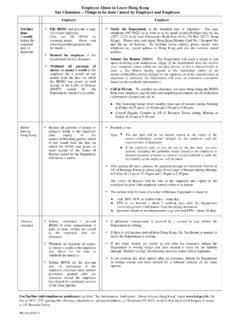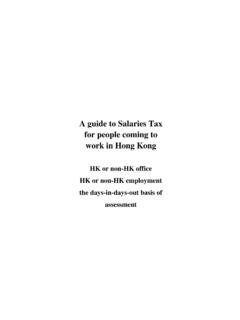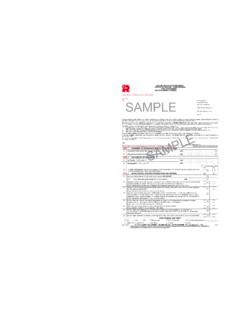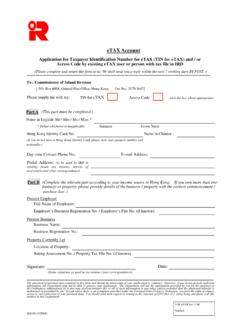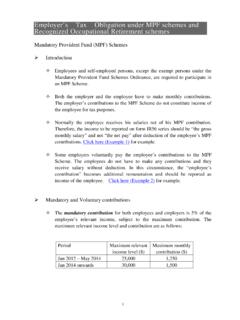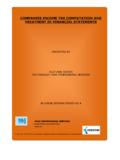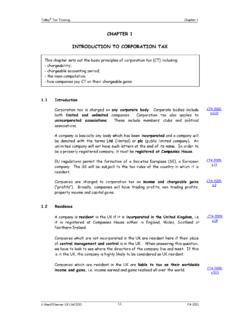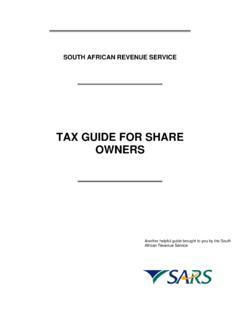Transcription of 利得稅計算表PROFITS TAX COMPUTATION - ird.gov.hk
1 This form may assist you to prepare the tax COMPUTATION of Assessable Profits (or Adjusted Loss) for your business, and to allocate the amount to partners. PART A PRO FORMA PROFITS TAX COMPUTATION Business Name: File No.: Year of Assessment / Item HK$ HK$ (1) Net Profit/(Loss) per the financial statements attached from to (A) ADDITIONS: Non-deductible expenses charged in the financial statements: (see Section G of Notes and Instructions Form BIR52) (2) Salaries/drawings paid to proprietor (or spouse)/partner (or spouse) (3) Share of motor car, entertainment, residential and utility expenses for private or domestic use (4) Cost of local/overseas travelling which is private in nature (5) Messing/meals and other benefits for proprietor (or spouse)/partner (or spouse) (6) Interest on capital or loan account paid to proprietor (or spouse)/partner (or spouse) (7) Rent paid to proprietor (8) Contributions to Mandatory Provident Fund Scheme (MPFS)
2 For the proprietor or any partner in excess of the amount allowable under the Inland Revenue Ordinance, and any contributions to MPFS for the spouse of the proprietor or any partner (see note B-1 in Part B) (9) Commissions without details of recipients (10) Penalties and fines (11) Donations not made to approved charitable organizations (12) Interest not incurred in the production of chargeable profits (13) Cost of purchase of machinery or plant, furniture and fixtures (14) Depreciation not calculated in accordance with the Inland Revenue Ordinance (15) Profits Tax, Property Tax paid/payable (16) Loss on disposal of machinery or plant, decoration, furniture and other fixed assets (17) Balancing charge (if the disposal proceeds in a Depreciation Allowance Pool exceed the sum of (i) reducing value b/f and (ii) the total new assets after deducting initial allowances) (18) Other expenses or losses not allowable for tax purposes (please specify) Sub-total of (2) to (18) (B) Sub-total of (A) and (B) (C) DEDUCTIONS : Allowable expenses or non-assessable income.
3 (see Section G of Notes and Instructions Form BIR52) (19) Net interest income exempted from payment of Profits Tax (20) Purchase cost of prescribed machinery / plant used for manufacturing purposes, type and blocks, bleaching, electronics / plastic / silk / textile manufacturing, weaving, spinning, knitting and sewing machineries ( 2598 6001) The Chinese version of this form may be obtained from the Department's web site at or through the "Fax-A-Form" service (Telephone No. 2598 6001). IR957 (4/2016) 1 Item HK$ HK$ (21) Purchase cost of computer hardware and software (22) gain on disposal / sale of fixed assets (23) Dividend and other non-assessable profits (please specify) (24) Mandatory contributions under the Mandatory Provident Fund Schemes Ordinance made in respect of the proprietor or any partner not charged in the financial statements (see note B-1 in Part B) (25) Capital expenditure on environmental protection facilities (applicable from year of assessment 2008/09 onwards) (26) Depreciation allowance calculation (see example B-2 in Part B).
4 10% Pool 20% Pool 30% Pool Total Allowance Reducing value b/f Add : total new assets Less : initial allowance (D1) Less : disposal proceeds (restricted to cost) Less : annual allowance (D2) Reducing value c/f Less : portion for private use (D3) Total depreciation allowances on machinery or plant (D1)+(D2)-(D3) = (D) (27) Industrial building allowance (see example B-3 in Part B) (28) Commercial building allowance (see example B-4 in Part B) Sub-total of (19) to (28) (E) Assessable Profits (C) - (E) Adjusted Loss (C) - (E) (29) Allocation of Assessable Profits or Adjusted Loss among partners (For completion of Item of BIR52) (see example B-5 in Part B) Emoluments Name of Partners and interest on capital Profit/Loss Sharing Ratio Balance Share of Assessable Profits or Adjusted Loss HK$ % HK$ HK$ (1)
5 (2) (3) (4) (5) TOTAL 100 2 PART B NOTES AND EXAMPLES B-1 Contributions to Mandatory Provident Fund Scheme (items 8 and 24 of pro forma COMPUTATION ) Maximum allowable amount for the deduction: Year of Assessment 2008/09 to 2011/12 $ 2012/13 $ 2013/14 $ 2014/15 $ 2015/16 onwards $ 12,000 14,500 15,000 17,500 18,000 B-2 Depreciation Allowance (item 26 of pro forma COMPUTATION ) 1. Machinery or plant ranking for depreciation allowances can be classified into 3 groups: Qualifies for Common examples of machinery or plant in each group 10% annual allowance Air-conditioning plant excluding room air-conditioning units 20% annual allowance Furniture (excluding soft furnishings which are allowable on replacement basis) Room air-conditioning units 30% annual allowance Motor vehicles, lorries, tractors and bicycles Concrete pipe moulds 2.
6 Example of Depreciation Allowance Calculation 20% pool 30% pool Motor car partly for private use 30% Total Allowance $ $ $ $ $ Reducing value b/f (1) 6,800 3,300 1,800 Add : total new assets 2,000 Less : initial allowance 60% 1,200 (2) 800 0 0 1,200 7,600 3,300 1,800 Less : total disposal proceeds (restricted to cost) 4,600 0 0 3,000 3,300 1,800 Less : annual allowance 600 (3) 990 (4) 540 2,130 Reducing value c/f 2,400 2,310 1,260 3,330 Less: portion representing private use of motor car (13) 180 (5) 3,150 (1) For new business, reducing value b/f is zero. (2) Cost of total new assets x 60% (rate of initial allowance), $2,000 x 60% = $1,200 (3) Reducing value x 20% (rate of annual allowance), $3,000 x 20% = $600 (4) Reducing value x 30% (rate of annual allowance), $3,300 x 30% = $990 (5) [Initial allowance and annual allowance of the relevant asset] x portion of private use, ($0 + $540) x 13 = $180 B-3 Industrial Building Allowance (item 27 of pro forma COMPUTATION ) Example of Industrial Building Allowance Calculation Location of property _____ Total Allowance $ $ $ Reducing value b/f Add : Addition of cost of construction 100,000 Less : initial allowance 20% 20,000 (1) 80,000 20,000 80,000 Less.
7 Annual allowance 4% 4,000 (2) 4,000 Reducing value c/f 76,000 24,000 (1) Cost of construction x 20% (rate of initial allowance), $100,000 x 20% = $20,000 (2) Cost of construction x 4% (rate of annual allowance), $100,000 x 4% = $4,000 3 B-4 Commercial Building Allowance (item 28 of pro forma COMPUTATION ) Example of Commercial Building Allowance Calculation Location of property _____ Total Allowance $ $ Cost of construction(1) 50,000 Less : annual allowance 4% 2,000(2) 2,000 Reducing value c/f 48,000 (1) For years of assessment 1998/99 onwards, the deemed cost of construction of a building acquired prior to 1998/99 is the capital expenditure incurred on construction less the aggregate of rebuilding allowances previously granted in all prior years.
8 (2) Cost of construction x 4% (rate of annual allowance is 2% for years of assessment 1997/98 and before), $50,000 x 4% = $2,000 B-5 Allocation of Assessable Profits or Adjusted Loss (item 29 of pro forma COMPUTATION ) 1. General Assessable Profits (or Adjusted Loss) will be allocated to each partner according to his/her profit and loss sharing ratio if none of the partners have drawn emoluments or interest on capital. If partners have drawn emoluments or interest on capital, these amounts will be taken into account in the allocation before the residue is shared among the partners. If a partnership business has an Assessable Profits, all partners will be allocated a share of profits. In no case will some of the partners be allocated a profit and others a loss.
9 If a partner is allocated a loss in the first allocation as in (E) in the example below, his share of the loss will be re-allocated to the other partners as in (F) in the example below. Similarly, if a partnership business has an Adjusted Loss, all partners will be allocated a share of the loss. 2. Example of Allocation of Assessable profits (or Adjusted loss) among partners Mr Chan, Mr Choi and Ms Li are partners of a business and they shared the profits or loss equally. The loss per financial statements of the business was $360,000. The partners, Mr Chan, Mr Choi and Ms Li drew salaries of $320,000, $200,000 and $50,000 respectively. As the partners' salaries are not deductible expenses, the Assessable Profits of the business after the adjustment will be $210,000.
10 (A) (B) (C) (D) (E) (F) (G) Partners Emoluments and interest on capital Profit/Loss Sharing Ratio Share of Balance Sub-total Re-allocation Share of Assessable Profits or Adjusted Loss $ $ $ $ $ Mr CHAN(1) 320,000(1) 1/3(1) 120,000(4) 200,000(5) 50,000(7) 150,000(8) Mr CHOI(1) 200,000(1) 1/3(1) 120,000(4) 80,000(5) 20,000(7) 60,000(8) Ms LI(1) 50,000(1) 1/3(1) 120,000(4) 70,000(5) +70,000(7) NIL(8) Total 570,000(1) 360,000(3) 210,000(5) 210,000(2) (The numbers in brackets demonstrate the sequence of the steps in working through the calculations.) Step (1) Fill in the names, emoluments/interest on capital drawn and profit/loss sharing ratios in the respective columns and add up the total in column (B). Step (2) Fill in Assessable Profits $210,000 at the total position of column (G).
